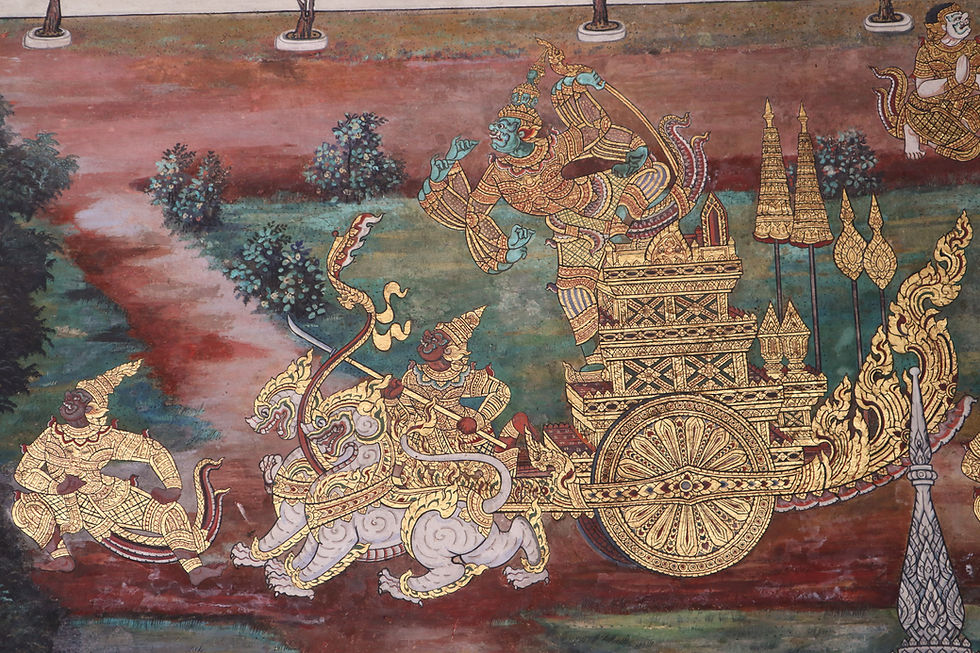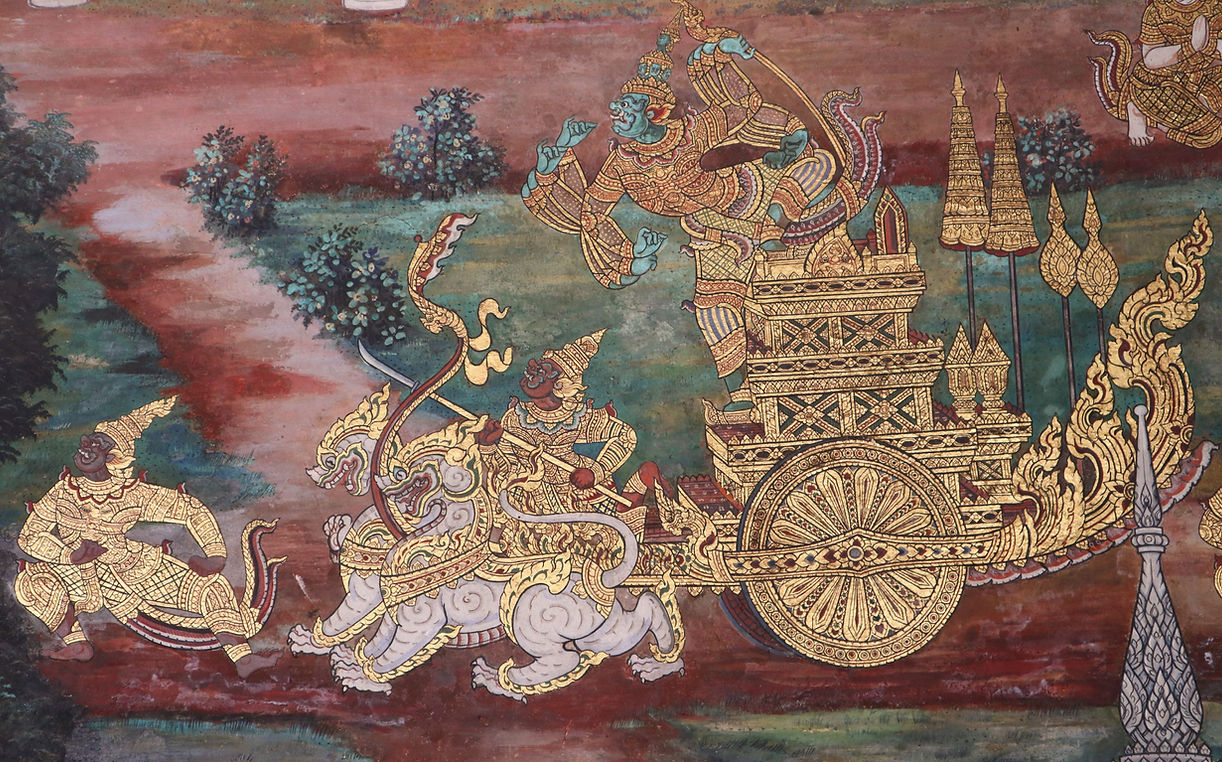Khon

What is"Khon" ?
Khon is derived from the Pali term "Kla" or "Kola", a drum that provides dancers with rythm. It a prestigious Thai masked dance-drama that arose in the 15th century during the Ayutthaya period (Thailand Foundation, n.d.). This authentic tradition combines dance, musical, theatrical, and ritual elements that collectively tells the legendary tale of the "Ramakien", a Thai Sanskrit epic based on historical and mythological themes and authentic Thai values (UNESCO, n.d.).

รามเกียรติ์
The story of the Ramakien
The Ramakien (รามเกียรติ์), which in english translates to “Glory of Rama”, follows to long battle between Phra Ram (อโยธยา), the human representation of universal law and order, and Tosakanth (ทศกัณฐ์), King of demons. Although there are many versions of the Ramakien, the common plot is that Tosakanth kidnaps Nang Sida, wife of Phra Ram, hoping to marry her (Elite, 2023). As a result, Phra Ram together with his companions, Hanuman and his monkey army, set out on a long journey to save Nang Sida whilst overcoming various obstacles along the way. The entire story centres itself around the universal, but more importantly, the Buddhist principle that in a battle between righteousness and evil, righteousness will always be victorious. The ultimate message of any khon performance is that with wisdom, discipline and goodness, lives will be peaceful. It also simultaneously embodies Thai cultural values (Mysakhonnakhon, n.d.).
รามเกียรติ์

Triumph of good over evil
Moral Integrity & Loyalty
Mutual respect between leader and follower
Traces of Ramayana
As the foundation for which Khon was built on is the Ramakien, one may wonder about the origin of this sanskrit epic.
Ever heard of the Ramayana?
The Ramayana is originally an iconic sanskrit epic that has travelled across Southeast Asia. In hindsight, it is the tale of King Rama on his journey to save his wife, Sida, who was kidnapped by the King of evil. Along this journey, King Rama and his companions face a series of obstacles that ultimately reflect Hindu values and lessons (Murphy, n.d.).
But just like how a simple dance can have limitless adaptations and versions, the Ramayana too was adapted by various SEA countries and altered to fit their own cultures, religions and values.
Enter “Ramakien”, the Thailand adaptation of the Ramayana.
.png)
.png)
The authentic Ramakien epic, which was written to be composed into the classic dance form, was recompiled during the reign of King Rama I (1782 -1809), who commissioned a series of Ramakien murals to be painted along the galleries of Wat Phra Kaew, Temple of the Emerald Buddha, in Bangkok (Thailand Foundation, n.d.).
These murals, together with the remaining written narratives of the epic, were compiled and composed into the dance-pantomime that we know as “Khon”.


01
Building of the Road
Phra Ram's monkey army builds a road to Longka to rescue Nang Sida. Disputes slow progress, but Hanuman intervenes, thwarts Tosakanth's fish plan, and completes the bridge within the deadline.
02
The Battle of Maiyarap
Maiyarap, ruler of an underwater city, allies with Tosakanth against Phra Ram. Fearing a prophecy, Maiyarap imprisons his relative. Phra Ram dreams of Rahu devouring the sun, and Hanuman’s protective attempt is foiled. Maiyarap seizes the opportunity, putting them to sleep and kidnapping Phra Ram. Hanuman embarks on a challenging journey to rescue him, overcoming obstacles in this popular Khon drama episode.
03
Phra Ram’s victory
Phra Ram continues fighting Tosakanth for years, unable to defeat him due to a protected heart. Hanuman, feigning loyalty, tricks Tosakanth. Hanuman switches the heart box, gains trust, and later aids Phra Ram, leading to Tosakanth's demise in battle.
04
Nang Sida walks through fire
Phra Ram doubts Nang Sida's faithfulness after defeating Tosakanth. To prove her purity, Sida suggests a fire-walking trial witnessed by gods. She emerges unharmed, affirming her innocence, and Phra Ram welcomes her to the royal throne.
(My Sakon Nakhon, n.d.)

Why was this story depicted through dance?
With a history of over 400 years, the ancient sanskrit is preserved through the traditional art of classic dance in order to cohesively encapsulate complex themes in Thai history, culture, virtues and religion. This idea of dance being a cultural preservation tool can be traced back to the Indian-influenced “Theravada Buddhist Cosmology” which mentions dance several times as a symbolic expression of religious ideas (Asian Traditional Theatre & Dance, n.d.)
Royal significance
Religious Roots
Although the Thai epic was made known in the 13th-14th century during the Sukhothai period, Khon made its first performance in the royal court during the Ayutthaya period in the 15th century and has since been considered a sacred art form (Kiriwat, 2001).
It was believed that the Khon dance forms are said to have descended from the gods, possibly holding the power to appease divine spirits. As a result, Khon demands utmost respect through the ceremonial honouring of teachers called the Wai Khru Khon Lakhon (Mongkolrat, n.d.) . With this, it is apparent how every aspect of this sacred art form reflects the authentic Thai values of the Ramakien.
So we know that Khon was highly honoured and regarded as a sacred art, especially in a royal context. But the question is why?
With it’s combined influence from buddhism and hinduism derived from both the original sanskrit, Ramayana, and the Thai adaptation, Ramakien, Khon was initially performed as a sacred Brahman Ceremony to honour Lord Vishnu (Thailand Foundation, n.d.). In Hinduism, it is believed that Rama, or Phra Ram, the main protagonist in Khon, is the 7th incarnation of Lord Vishnu. Although it is also believed that Phra Nam is the incarnation of Buddha, a religious figure representative of complete enlightenment, peace and wisdom (History, 2023). While this religious overlap is bound to have a rather complex nature, simply put:
Phra Ram in Hinduism is regarded as the incarnation of Lord Vishnu whereas in Buddhism, Phra Ram is the manifestation of Buddha. Regardless, it is certain that with its rich religious and royal origin, Khon holds high honorary stature within Thai culture.
References
Asia Society. (n.d.). The Ramayana. https://asiasociety.org/education/ramayana
Asian Traditional Theatre and Dance (n.d.). Early Periods. https://disco.teak.fi/asia/early-periods/
Elite Plus Magazine. (n.d.). The King and Khon: The Story of How His Majesty King Bhumibol Adulyadej the Great Saved Thai Traditional Dance. https://www.eliteplusmagazine.com/Article/detail/306
History. (n.d.). Buddhism. https://www.history.com/topics/religion/buddhism
Kiriwat, A. (2001). Khon, masked dance drama of the Thai epic Ramakien. https://digitalcommons.library.umaine.edu/cgi/viewcontent.cgi?article=1644&context=etd
Mongkolrat, T. (n.d.). The King and Khon: The Story of How His Majesty King Bhumibol Adulyadej the Great Saved Thai Traditional Dance. https://www.thailandnow.in.th/arts-culture/the-king-and-khon-the-story-of-how-his-majesty-king-bhumibol-adulyadej-the-great-saved-thai-traditional-dance/
My Sakonnakhon (n.d.). Ramakien Story Thailand Khon Drama Summary. https://mysakonnakhon.com/ramakien-story-thailand-khon-drama-summary/
Thailand Foundation. (n.d.). Khon: The Crown Jewel of Thai Performance Arts. https://www.thailandfoundation.or.th/culture_heritage/khon-the-crown-jewel-of-thai-performance-arts/
UNESCO. (n.d.). Khon, masked dance drama in Thailand. https://ich.unesco.org/en/RL/khon-masked-dance-drama-in-thailand-01385#:~:text=Khon%20has%20a%20strong%20didactic,and%20in%20dance%20masters'%20households.

